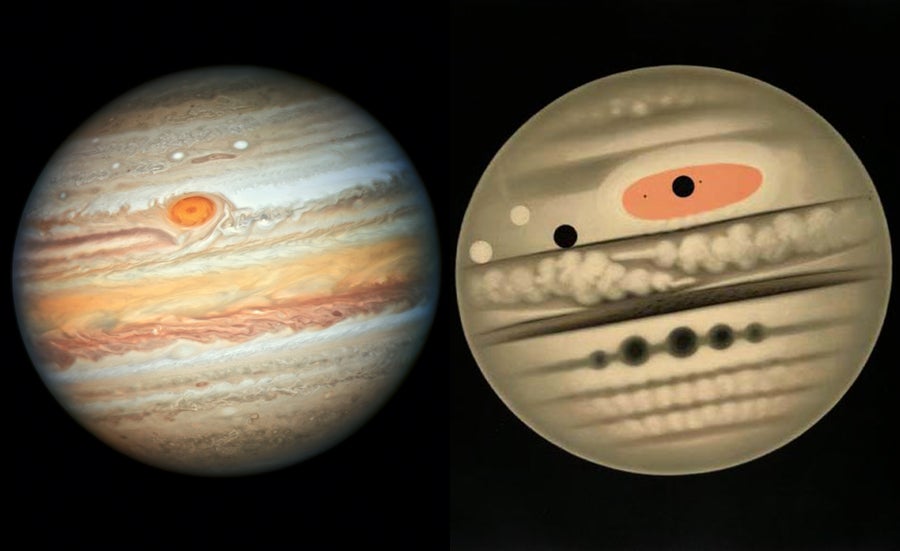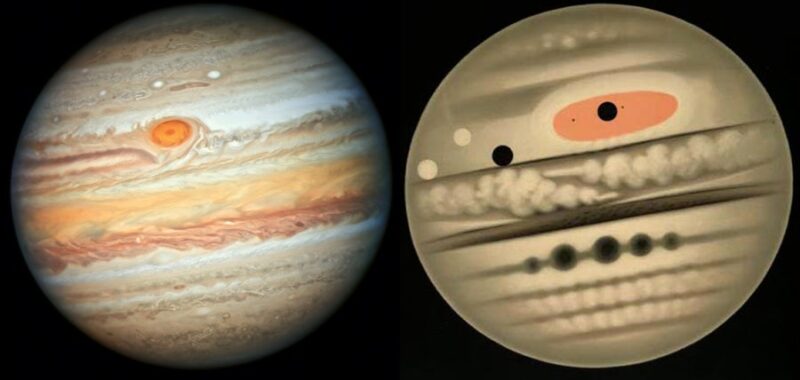In a solar system full of wonders, Jupiter’s Great Red Spot still stands out.
This lushly red oval is obvious even through small telescopes, looking like a baleful eye staring out from the enormous gas giant planet. The Great Red Spot (or GRS) is so huge that you could drop the entire Earth into it and our planet would plunge through without touching the sides.
It’s been around for centuries and holds many mysteries, but we’re learning more about it all the time. Research recently published in the journal Geophysical Research Letters indicates that the GRS isn’t as old as once thought and implies that while it may yet last for many years to come, its days are numbered.
On supporting science journalism
If you’re enjoying this article, consider supporting our award-winning journalism by subscribing. By purchasing a subscription you are helping to ensure the future of impactful stories about the discoveries and ideas shaping our world today.
The GRS is Jupiter’s most iconic feature. I’d say “surface” feature, except Jupiter doesn’t really have a surface; what we see is actually clouds atop an atmosphere that’s thousands of kilometers deep. The GRS is in reality a spot of remarkably vast and persistent weather churning in the planet’s clouds; technically speaking, it’s an anticyclonic vortex—a counterclockwise-rotating high-pressure system—with gases spinning around the center at speeds of 450 kilometers per hour. That’s about as fast as the highest wind speeds ever recorded in a tornado on Earth!
This giant storm—the largest known in the solar system—is made up of two regions. One is an oval made up of reddish gases, and the other is a surrounding whiter, thinner band of gas (called the Hollow). The GRS lives in Jupiter’s South Equatorial Belt, one of the many bands across the planet’s face that give it a striped appearance. These bands are latitudinal wind patterns akin to the jet stream on Earth, but they are more complicated because of Jupiter’s lack of surface, the enormous convective currents of gases rising and falling through the atmosphere and immense air-bending forces from the giant planet’s rapid nine-hour-and-55-minute rotation.
Unlike Earth’s hurricanes that can wander across sizable swaths of our planet, storms on Jupiter tend to stay in their latitudinal lane, confined by powerful jet streams. That confinement also sustains the GRS, making the storm extremely long-lived, but its actual age has been an ongoing astronomical enigma.
In 1665 Italian astronomer Giovanni Cassini spotted—so to speak—a dark oval on Jupiter’s face. It was seen on and off again until 1713, and the recorded location of this “permanent spot” was the same as that of the current GRS. Cassini is credited with discovering it, though it may have been seen by another astronomer in 1632; if that is true, it lasted at least 80 years.
Despite astronomers’ ongoing monitoring of Jupiter, however, after 1713 this spot seems to have disappeared. The next known sighting of a storm at that latitude dates to 1831, well over a century later, when astronomers reported a dark spot there. (It wasn’t described as red until the 1870s!) This spot—our familiar, beloved GRS—has been continuously observed ever since, making it nearly 200 years old.

Jupiter as seen by the Hubble Space Telescope on June 27, 2019 (left). An illustration by the French artist and astronomer Étienne Léopold Trouvelot of Jupiter as observed on November 1, 1880 (right).
NASA/ESA/A. Simon/Goddard Space Flight Center/M. H. Wong/University of California, Berkeley (left); The Picture Art Collection/Alamy Stock Photo (right)
Curiously, old drawings and even early photographs show the GRS as being much wider than it is today; the first photograph ever taken of it, by Irish astronomer Agnes Mary Clerke in 1879, shows it as a flattened oval with a longitudinal (east-to-west) width of around 40,000 kilometers—more than double the width of the more circular storm we see today. Somehow the GRS has been significantly changing its shape and shrinking across the past century and a half.
Therein blows the mystery. Was the spot seen by Cassini and others in the 17th century the same feature as today’s GRS? If not, as seems likely, did that original spot dissipate and a new one grow at the same latitudinal location? And if that’s the case, how could this happen, and why do these spots change in size and shape? Remember, we’re talking about a weather system the size of some planets.
This is the focus of the newly published study. Detailed observations of Jupiter show just how complex and dynamic the gigantic planet’s atmosphere is. Smaller storms form and dissolve, while others merge and grow. Many last for years, and sometimes they can generate much, much larger features.
The study’s authors used numerical models of the flow of Jupiter’s atmospheric gases, solving complex fluid dynamics equations to simulate their motion and behavior, then compared the results with a broad range of archival measurements of the GRS across the centuries. Looking at how the shapes of such vortices change over time, they conclude the permanent spot seen by Cassini was not the same as the GRS; the growth rate in the width of the spots doesn’t match.
The researchers also modeled different origin stories for the GRS to see if any of them mirrored observations. Despite being common, merging storms don’t correspond well to what’s seen. While they can coalesce and form a larger system, even four or five storms glomming together cannot create a system as sprawling as the GRS. Moreover, no such vortices were seen in the gap years of 1713 to 1831, and they almost certainly would have been visible.
Another formation mechanism could be a superstorm, an upwelling of warmer material from Jupiter’s depths that punches out to the cloud tops. Such an immense storm erupted on Saturn in 2010, creating a spectacular weather system that faded to faintness over a year or two. Simulating such an event on Jupiter, the scientists found that this could form a single anticyclonic system, but, like the merging vortices, a singular upwelling of material couldn’t scale up to reach the GRS’s observed size and shape. Also, no such superstorms have ever been seen forming on Jupiter at that latitude, strengthening the conclusion that something else must be responsible for the GRS.
That “something else,” they say, could be what’s known as a south tropical disturbance. This is a breach of sorts that occurs when the flow of gases in one of Jupiter’s bands extends in a northerly or southerly direction, pushing into an adjacent band. This can impede the adjacent band’s flow, creating a swirling maelstrom that can grow quite large. The scientists simulated this process and found that for a sufficient velocity range in the interacting winds, it can form a huge spot that matches the GRS. Importantly, they found that this mechanism can also account for the GRS’s historic and ongoing changes in size and shape.
They conclude, then, that the GRS we see today formed in this manner in 1831, as a separate entity from the spot seen before. This would make the GRS 193 years old.
But how old will it get? The GRS’s well-documented shrinkage has been accelerating since the 2010s. It’s not clear when or even if Jupiter’s angry eye will disappear—it’s been around a long time—but the fact that Cassini’s “permanent” spot was so ephemeral implies that even the GRS may vanish in the long run. Future astronomers may see a spotless Jupiter.
But the one thing we know for certain is that the King of the Planets doesn’t sit still. Even if the GRS fades and blows away, another successor spot will likely rise to take its place.

